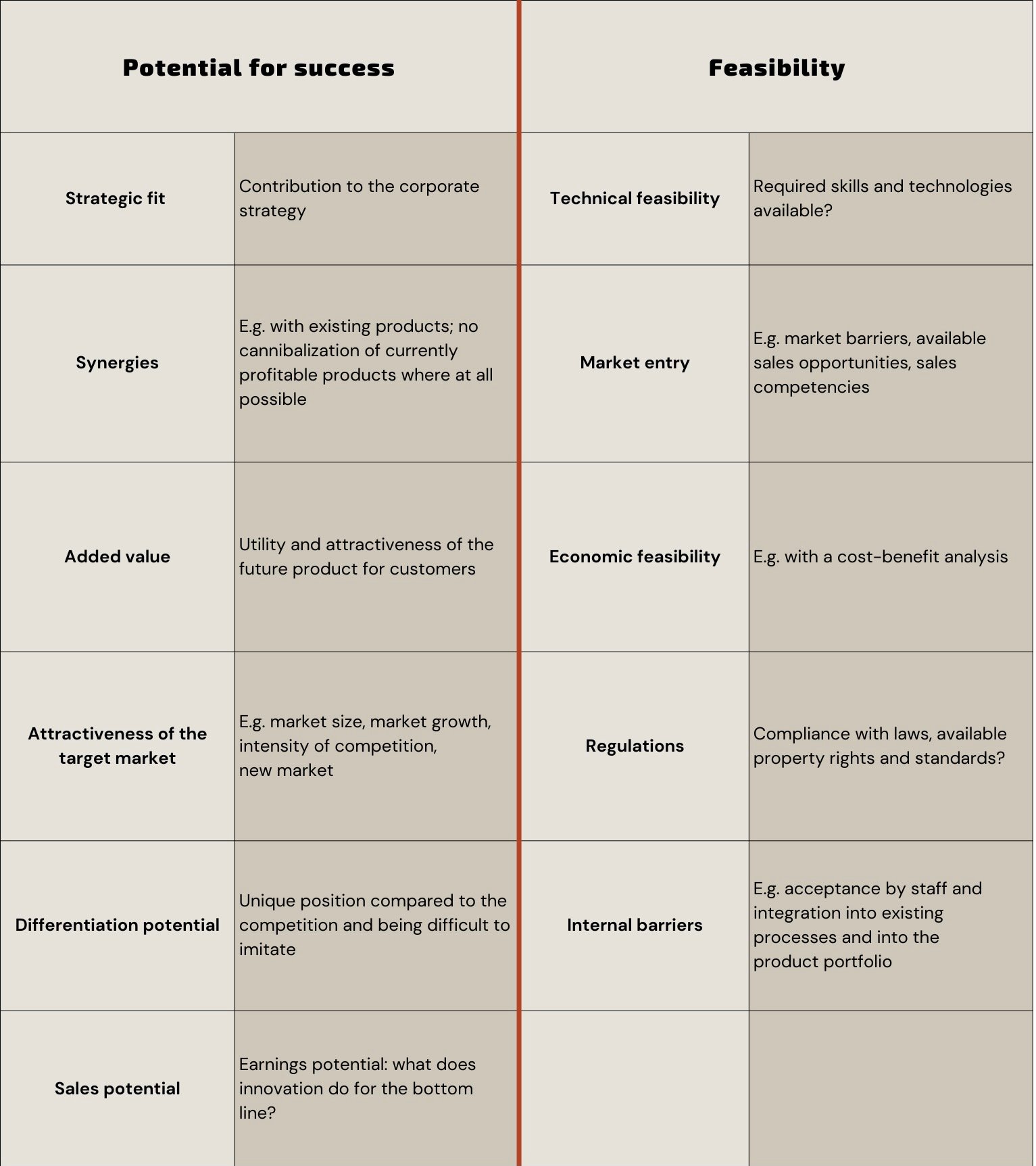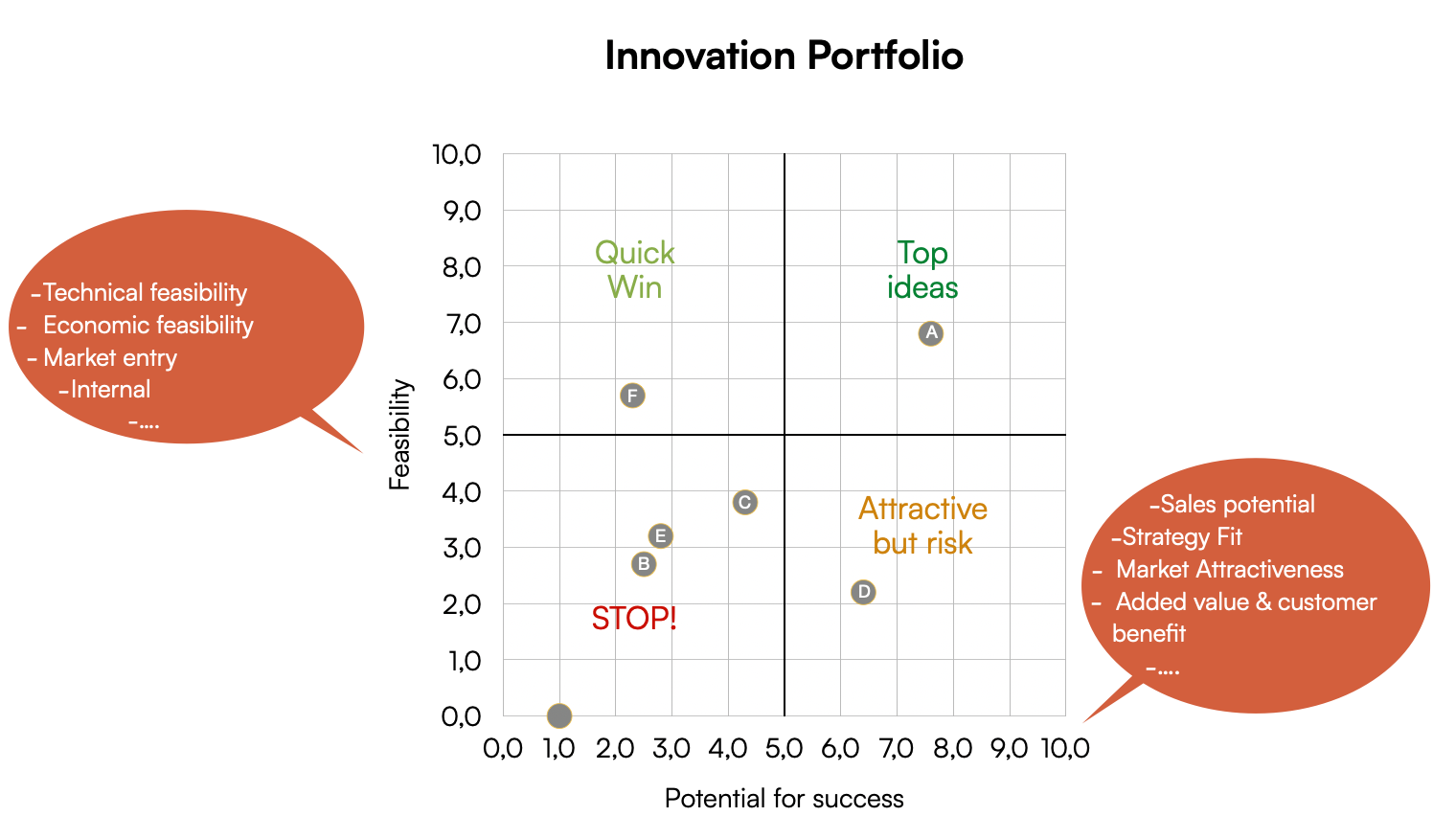Mastering Innovation Management: Evaluating and Optimizing Ideas
How to proceed efficiently and in a structured manner when evaluating ideas and assessing your innovation portfolio.

In the innovation process, it is your task as the innovation manager to manage and evaluate the incoming ideas. After all, not every idea has the same quality from the start, and it is crucial to filter out and refine the most promising ones. This is the only way to ensure that work is done on the right innovations and that a successful innovation portfolio is created.
But how do you, as an innovation manager, determine which ideas are promising? One approach is to vet all ideas to see if they provide utility to the customer and if they are consistent with your business strategy. The sales potential should also be taken into account. It is important to remember that innovation is not just about products – service innovation can also play a role. Therefore, ideas in this area should also be collected and included in the portfolio evaluation.
Evaluation criteria for ideas helps ensure that only the right projects are worked on and gives you, as an innovation manager, the opportunity to properly deliberate on selecting ideas for your portfolio. By striking the right balance between customer benefits and sales potential, you can successfully work on developing your innovation portfolio.
Why is it important to evaluate ideas and innovation projects?
The saying "doing the right projects and doing the projects right" leads us to a crucial point in innovation management: it is about selecting the right projects and implementing them successfully. But how can companies ensure that they are choosing the right projects?
This is where idea evaluation comes into play. Evaluating ideas has three important areas of application. Firstly, ideas are evaluated right from the beginning to determine whether or not they should be financed. You check to see if the idea is suitable for the company and if it has the potential to be successful.
Secondly, ideas and innovation projects are regularly evaluated to assess their value and utility. Over the course of a project, the framework conditions for an innovation change due to new findings and changes in the environment. This can also change the potential success of an idea.
Finally, the evaluation of ideas serves to use resources efficiently. By continuously reviewing the utility of a project, companies can identify early on whether it makes more sense to cancel the project or redeploy resources elsewhere.
Idea evaluation is a revolving process that helps ensure that companies can carry out successful innovation projects and thus enjoy long-term success.
Components of successful ideas or innovations
The key to a successful company lies in the ability to develop new ideas and innovations. However, this requires understanding the various components of a successful idea or innovation – and these always start with the definition of success. So when you develop an idea or innovation, you must first determine what goal you want to achieve with it. Do you want to influence the market? Or do you want to make your company more efficient by using new technologies? It is important to clearly define your goal before moving forward.
In addition to the target, other factors must also be taken into account. For example, the idea needs to be vetted to make sure it is feasible and not technically overwhelming. In addition, the idea must offer a competitive advantage and it should be ensured that the company has the resources to put it into practice. It is also important that the idea is designed in such a way that it can be easily adapted if the requirements of the market change.
So, in order to create a successful idea or innovation, one must first and foremost clearly define one's goal and consider all other relevant factors. This is the only way to ensure that your ideas and innovation will actually succeed.
How do you evaluate ideas or innovation projects?
There is a wide variety of evaluation criteria. In essence, it is about weighing up the opportunities and risks. When it comes to ideas in particular, remember that you can distinguish between different types of ideas. The word "idea" can be defined slightly differently in every company. Some conceive of a rough outlook for the future or a vision; others think of trends or areas of opportunity; and then other people think of a very specific technical solution idea or use case. Depending on the type, you can evaluate differently or have a different basis for decision-making.
The ideas / innovations are characterized by two essential features:
- Potential for success – meaning they have the highest possible utility.
- Feasibility – meaning the implementation should be achievable; a high chance of implementation with as little risk and cost as possible.

Evaluation criteria in the innovation portfolio
An extremely useful tool in the decision-making process is the innovation portfolio, which can be displayed very clearly with the help of an XY chart. It provides a clear overview of the top topics with a high potential for success and high feasibility, while ideas with low a potential for success but high feasibility are classified as quick wins. Ideas with a high potential for success but low feasibility are attractive but risky and should therefore be monitored closely. The rest of the ideas must be scrapped.

By assigning this as a group process, all participants gain profound insights. For this reason, it is advisable to include as many employees as possible in the evaluation process. The innovation portfolio is an excellent basis for discussions and decisions.
Furthermore, XY charts can easily be expanded with an additional dimension. The size of the bubbles, for example, can represent the quantitative revenue potential, stage or effort.
Conclusion
Innovation management is a complex task, but companies can achieve great success if they take the right path. A well-maintained innovation portfolio and efficient idea evaluation based on the right criteria are the cornerstones of successful innovation management. Using these tactics, companies improve idea management and get a good overview of their innovation portfolio. So, if you want to attach more importance to your innovation agenda, I would recommend you start with above tips and trust the results – always assuming that the processes and structures of your innovation management are defined and implemented.
The world of innovation management encompasses much more than just processes and procedures - it requires holistic thinking. Find out how innovation managers can increase their company's innovative strength through holistic innovation management. Dive into the blog article "House of Innovation: How CEOs make their company innovative" and discover new ways to promote innovation.











